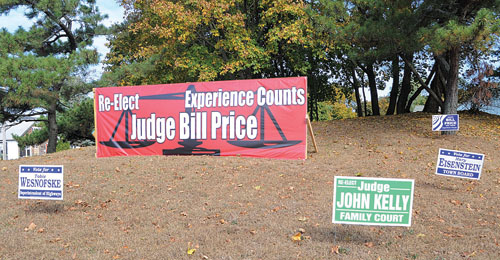Experts break down the science behind the political signs

A colony of political yard signs exists on a rise of land at the intersection of Main Road and Aldrich Lane in Laurel.
“Experience counts. Re-elect Judge Bill Price,” one large sign reads. “Vote for Tobie Wesnofske, Superintendent of Highways,” another says.
The barrage of signs isn’t an unusual sight; indeed, during election years, political signs seem to be everywhere. And while their design scheme may seem straightforward enough — a dabble of red, a smattering of blue and the candidate’s name in block letters are all typical features — considerable thought goes into the creation and execution of the average 18-by-24-inch sign.
“My idea of a good lawn sign is whether or not it can be read from a car driving past it at 40 miles per hour,” said Peter McGreevy, chairman of the Southold Republican Committee. He said the political yard signs of all Republican nominees in Southold Town use the same fonts and colors to maintain consistency across the party slate.
“The name of the person and what office they’re running for is the most important message to get across,” he said.
Art Tillman, chairman of the Southold Democratic Committee, has similar ideas regarding the efficacy of political yard signs.
“It’s not a science as to what works and doesn’t work,” Mr. Tillman said. “We generally go with capital letters. The colors and the contrast are important.”
Extremely important, he found out.
“Eight years ago, possibly 10, we brought a couple of people into our meetings who were supposedly designers,” Mr. Tillman said. “They recommended signs with a light green background with white letters – or vice versa, I don’t recall. Anyway, when we got the signs we were shocked. When we put them on the road you could hardly read them. It was a disaster.”
What works best? After 25 years at Wedel Signs on West Main Street in Riverhead, designer Ted Squires has concluded that simplicity is key.
“As far as the wording goes, keep it simple,” he said. “Include your name, what you’re running for, and either ‘elect’ or ‘re-elect.’ The more you put on [the sign], the less people will read.”
While it remains to be seen which candidates will prevail at the polls — and, ostensibly, whether or not their placards could be judged as effective or not — political yard signs have had a place in American history since the years immediately following World War II, said Stanley Klein, professor of political science at C.W. Post Long Island University in Brookville.
The reason, he said, is simple: more Americans owned houses with lawns following the war.
And political yard signs do work, Mr. Klein said, although he considers door-to-door stumping for votes a candidate’s best shot of getting elected.
“In Nassau County during the 1968 election, there was an assemblyman running by the name of Marty Ginsberg,” Mr. Klein said. “He had 45 four-by-eight signs put up around his election district. Newsday’s comment [at the time] was, ‘It is no longer Plainview. It is Ginsberg-ville.’ By the way, he was re-elected.”
More than 40 years later, local candidates are still hoping that a purposefully positioned yard sign can make the difference between defeat and victory.
“I think they’re effective in getting the message out that a candidate is running,” Mr. McGreevy said. “In some ways, they’re the equivalent of wearing your favorite sports team’s cap or jersey.”




